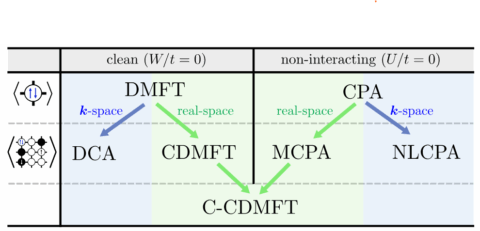Coherent cellular dynamical mean-field theory (C-CDMFT): a real-space quantum embedding for disorder and correlations
We’ve posted a new preprint introducing C-CDMFT, a real-space cluster method that treats electronic interactions and disorder on equal footing. The approach combines the molecular coherent potential approximation (MCPA)—including its Blackman-Esterling-Berk (BEB) treatment of off-diagonal disorder—with cellular DMFT (CDMFT) to capture short-ranged nonlocal fluctuations and configuration-specific effects in disordered, strongly correlated systems.
What’s inside (highlights):
- Method: A controlled cluster algorithm (size (N_c)) that becomes exact as (N_c\to\infty); formulated entirely in real space so symmetry-breaking fields and “disorder diagnostics” are straightforward. See the self-consistency workflow diagram on p. 8 (Fig. 5).
- Applications: First results for the half-filled 2D Anderson–Hubbard model, including (i) the “dirty” Mott transition and (ii) effects of diagonal vs. off-diagonal disorder on the magnetic phase diagram and staggered susceptibility. p. 9–13
- Key findings: Interaction-driven screening restores spectral weight in the disorder-split metal; cluster (nonlocal) correlations lower the critical (U) for the Mott transition relative to single-site theory; off-diagonal disorder changes magnetic trends in a way that can be traced to specific bond configurations via the disorder diagnostics. p. 10–13
Authors: Patrick Tscheppe, Marcel Klett, Henri Menke, Sabine Andergassen, Niklas Enderlein, Philipp Hansmann, Thomas Schäfer.
Date: July 30, 2025. Title page
Read the preprint:
arXiv: 2503.10364v2 — “Coherent cellular dynamical mean-field theory: a real-space quantum embedding approach to disorder in strongly correlated electron systems” (PDF).
